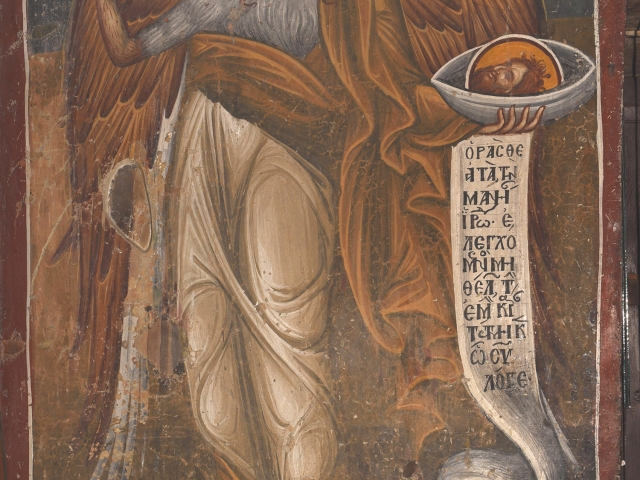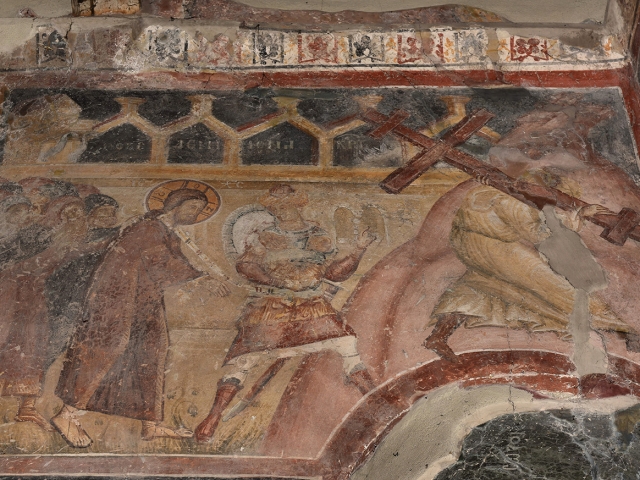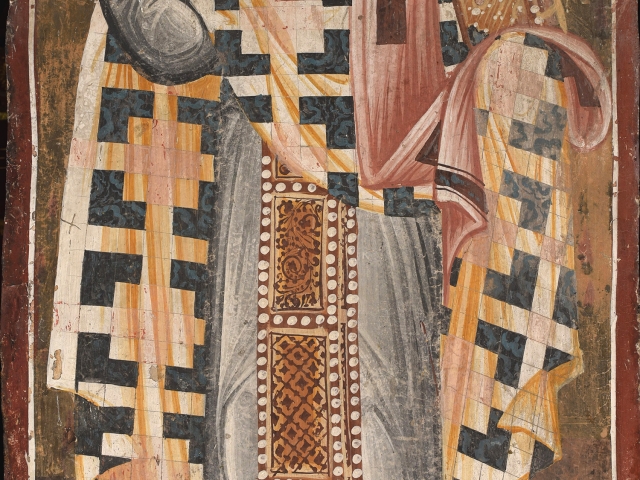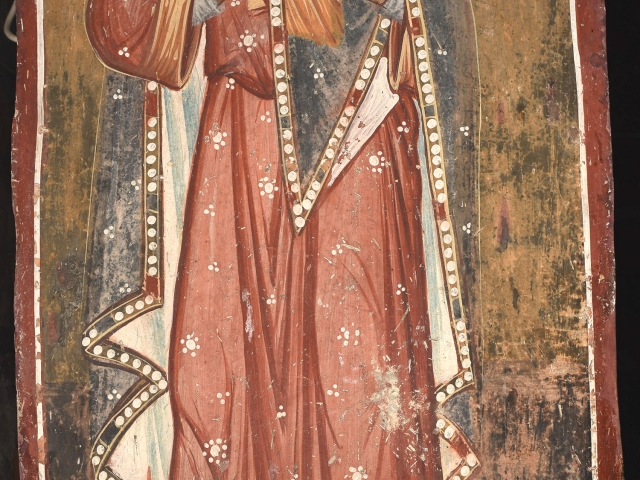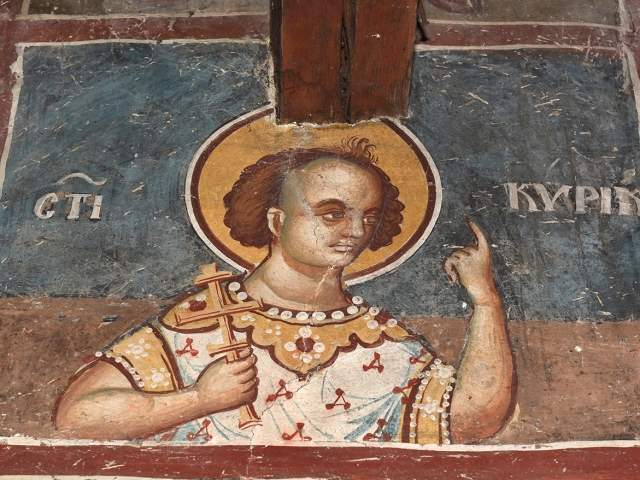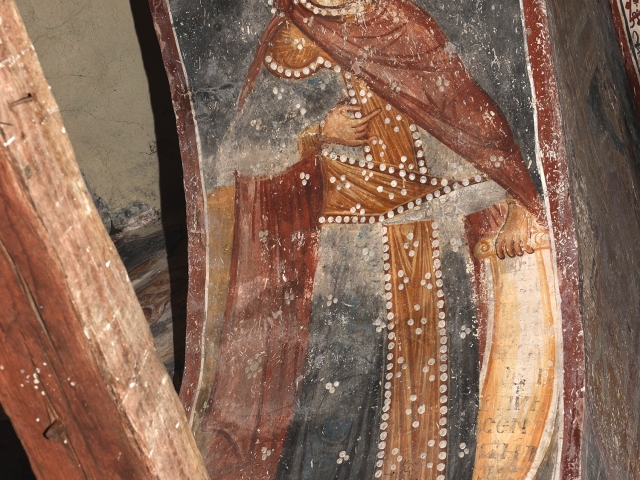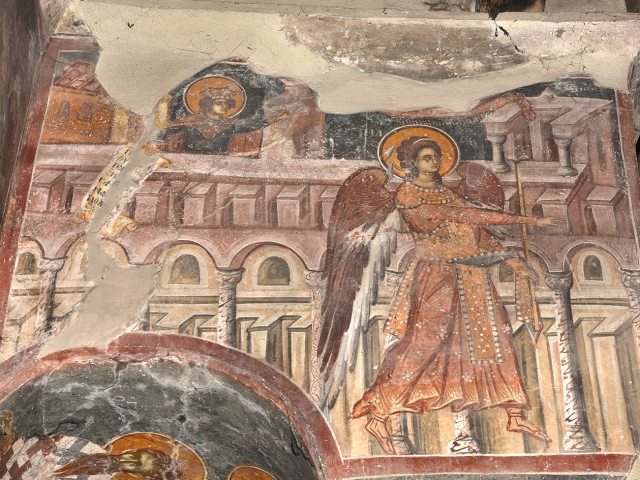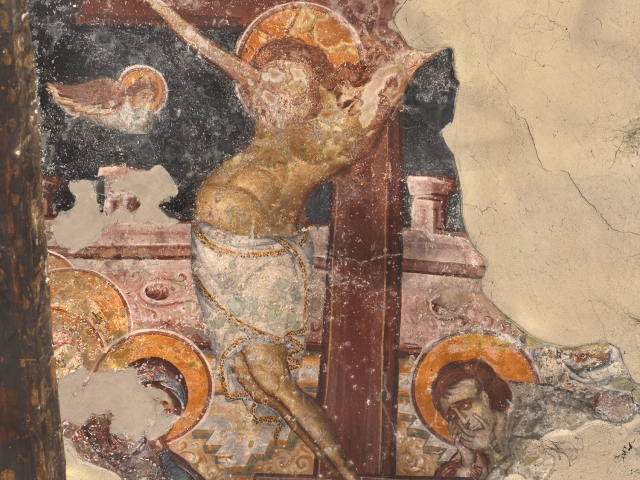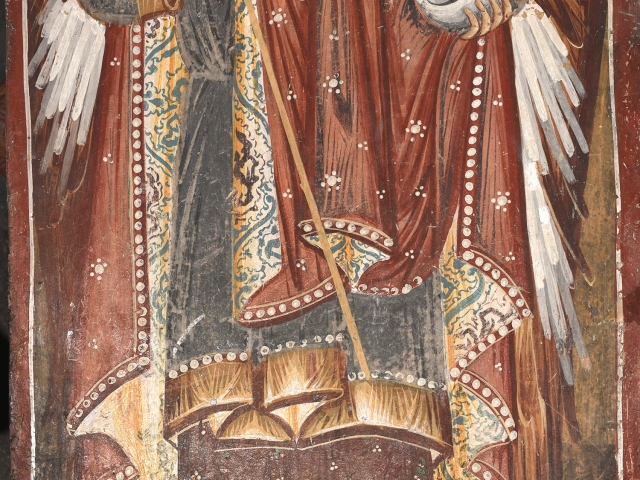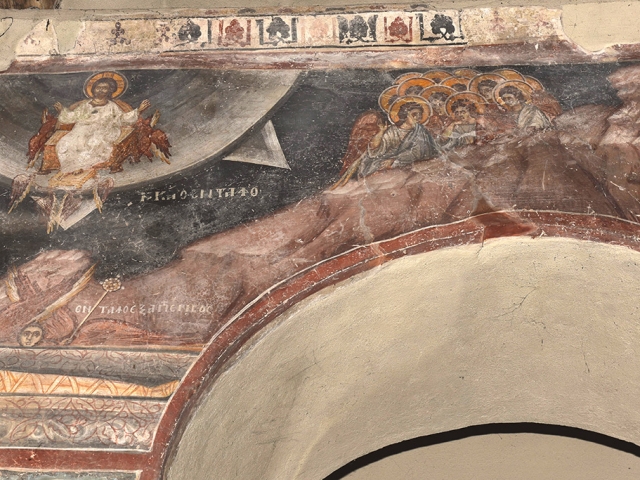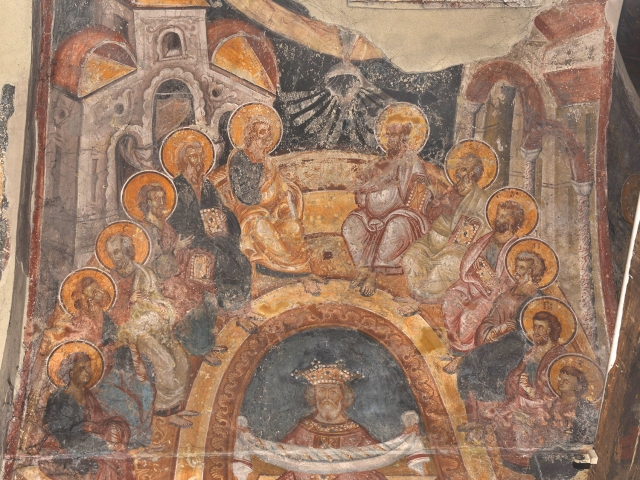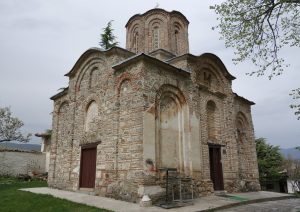
St. Nicetas Church near Čučer, view from the southwest
The church is situated at about 15 km northwest from the town of Skopje, Republic of Macedonia. It is located at an equal distance from the villages of Čučer, Banjane and Gornjane in Skopska Crna Gora.
St. Nicetas Church is known as a zaduzhbina – a temple built for the salvation of the soul, of a ruler of Serbian King Stefan Uros II Milutin (1282-1321). In all probability the initial monastery church was founded between 1183 and 1192 by the grand zhupan Stefan Nemanja, but it is also possible for this to have happened earlier, in the 11th-12th cc. at the commission of an unknown Byzantine aristocrat.
Several written sources about St. Nicetas from the 14th c. are kept at the archive of the Hilandar Monastery on Athos. A total restoration on the basis of the old St. Nicetas church took place in 1299 or 1300 and was made by King Milutin, which is witnessed by a chrysobull of Emperor Michel IX Palaeologus. From the relatively same period is dated another chrysobull of Andronicus II Palaeologus, father and co-emperor of Michael IX, which reads that St. Nicetas is a cloister of the Hilandar pyrgos Chrousia. In 1308-1309 St. Nicetas became a cloister of the Hilandar Monastery, which is witnessed by a charter of Emperor Andronicus II Palaeologus, father and co-emperor of Michael IX. In 1321 by decision of King Milutin the monastery became directly subordinated to the hegumen of the Hilandar Monastery.
During the Ottoman period after having been devastated, the church was reconstructed thrice: in 1483/1484, at the end of the 16th c, and in 1846-1847.
The building is solid, made of stone and brick, with brick decoration. The outside dimensions are as follows: 11.5 m length, 7.7 m width and 12.8 m height. The church is of the cross-in-square type with a dome and an octahedral drum. The dome is supported by four rectangular pillars connected with vaults. The facades are decorated with blind arches. The entrances to the temple are two: from the south and from the west.
The semi-destroyed about the middle of the 16th c. high parts of the church were restored by the end of the same century and a single-nave vaulted chapel was added in the eastern half of the southern wall of St. Nicetas. The chapel was decorated and dedicated to St. John the Baptist. It was destroyed in 1928 on demand of Metropolitan Barnabas.
Some architectural reconstructions were also carried out in 1846 when with the donations of priest Uroš and hadji Trayko Doicinović from Skopje the destroyed dome was restored and a vast space (the so-called sofra) was added to the west and to the south of the church; it served as a narthex and was also destroyed in 1928.
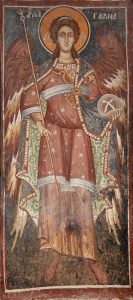
Archangel Gabriel, St. Nicetas Church near Čučer
The monument features four painting layers – from the 14th c., from 1483/1484, from the end of the 16th c. and from 1846.
The earliest frescoes were created between 1322 and 1324 and are among the classical monuments of the art of the Palaeologean period. They occupy almost entirely the church’s interior and were made by the famous Thessaloniki master Michael Astrapa and icon-painters of his atelier. Until recently on the basis of the reading of the icon-painter’s signature on the shield of St. Theodore Tyron it was believed that the masters were two: Michael and Euthychius.
In 1483/1484 the frescoes were ‘restored’ by anonymous but very skilled Kastoria icon-painters. Form the paintings of the end of the 16th c. there are only some fragments in the western part of the southern facade of the church. The eastern part used to be occupied by the chapel of St. John the Baptist, which is now destroyed.
In 1846-1847 the Debar icon-painter Dicho Zograf (Dicho Krustević) decorated the dome and painted some icons for the new iconostasis.
Frescoes of 1483/1484
The date of the re-decoration at the end of the 15th c. is stated in the donor’s inscription above the southern entrance. Since the icon-painters who ‘restored’ the church have kept and followed the original murals, sometimes it is very hard to distinguish between the old and the new frescoes. Some of the original images have been restored partially (for example the heads of St. Peter and of Archangel Michael were painted in the 15th c. but their bodies are from the 14th c.; parts of the scene of Christ’s Baptism were also restored), while others have been painted on entirely new plaster in 1483/1484. The latter painting layer occupies mainly parts of the lower registers of the pilasters, the vaults, as well as parts of the second register on the southern and the northern walls.
In 1483/1484 the eastern parts of St. Nicetas were decorated with the scenes of Ascension and Pentecost (eastern vault, altar); Archangel Gabriel from the Annunciation scene (western wall on the northeastern pilaster); an illustration for the first canon for Holy Saturday “Up on the throne, down in the grave” (northern wall in the arch between the southeastern pilaster and the eastern wall, above the entrance to the prothesis).
In the vaults and arches formed between the pilasters, in the 15th c. were depicted: Transfiguration and Entry into Jerusalem (western vault under the dome); the Descent into Hell and Crucifixion (northern vault under the dome); Prophet Solomon and St. Cosmas of Maiuma (arch at the northwestern pilaster); Pilate’s Court and the Mocking of Christ (southern side of the arch between the northwestern pilaster and the western wall) and the Road to Golgotha (eastern side of the northwestern pilaster).
In the second (from the bottom up) register the Kastoria icon-painters also presented the following scenes from the Passion and Miracles of Christ: The Last Supper (southern wall); Judas’s Repentance and Death (eastern side of the northwester pilaster), the Healing of the Blind (southern wall of the northwestern pilaster).
The rest of the independent figures painted in the 15th c. are St. John the Baptist (southern wall), St. Nicholas (western side of the southwestern pilaster), Archangel Gabriel (southern side of the northwest pilaster), a half-length image of St. Cyricus and a standing figure of St. Menas (western side of the northwestern pilaster), and a half-length image of St. Hilarion of Maglen (highest part of the eastern wall of the northwest trave).

Rebellion and Suicide of Judas, St. Nicetas Church near Čučer and Treskavec Monastery
Greek and Cyrillic.
St. Nicetas Church is among the works defined as works of the chief master who is responsible for the establishment of the leading atelier of the Kastoria artistic production of the 1480s-90s. The surviving monuments reveal that the atelier was especially active for a period of about four years in the 1480s. The atelier brought forth the icon-painting teams that worked in different areas of the Balkan Peninsula until the end of the 1530s. Among the works of this atelier are the murals in the Old catholicon of the Transfiguration Monastery (Great Meteor, 1483), part of the frescoes in the Dormition Monastery (Treskavec, 1483/1484) and in St. Nicholas of Nun Eupraxia in Kastoria (1486), as well as the fragments in the church of St. Peter and Paul in Aiginio (Pieria, Greece, 1485).
Tsveta Kuneva

Entry into Jerusalem, St. Nicetas Church near Čučer and St. Nicholas Church of Nun Eupraxia in Kastoria, details
Месеснел, Ф. Живопис цркве Св. Никите у Скопској Црној Гори. – Годишњак Скопског Филозофског факултета, І, 1930, 139-154.
Millet, G., A. Frolow. La peinture du Moyen âge en Yougoslavie. Belgrade, 1930, pl. 50.1-2, 51.1, 51.3-4, 53.2-4.
Татић, Ж. Архитектонски споменици у Скопској Црној Гори. ІІІ. Св. Никита. – Гласник Скопског научног друштва, ХІІ, 1933, 127-134.
Petkovic, V. La peinture serbe du Moyen age. Beograd, 1934, 35-37.
Hamann–MacLean, R., H. Hallensleben. Die Monumental malerei in Serbien und Makedonien von II. bis zum frűhen 14. I. Jahrundert, Giessen, 1963, fig. 223, 234-235, plan 26-28.
Миљковић – Пепек, П. Црквата Св. Никита во Скопска Црна Гора како историско-уметнички споменик. – Споменици на средновековната и поновата историjа на Македониjа І, 1975, 379-386.
Марковић, М. Прилог проучавању утицаја канона Велике суботе на иконографију средњовековног сликарства. – Зборник радова Византолошког института, 37, 1998, 167-183.
Тодић, Б. Српско сликарство у доба краља Милутина. Београд, 1998, 343-346.
Марковић, М. Свети Никита код Скопља. Задужбина краља Милутина. Београд, 2015.

